MIND MAPPING FOR PROJECT PLANNING
Mind mapping for project planning
Planning is the second of five stages of project management. It is the phase that arrives after the initiation stage and that means taking care of every little detail necessary for a successful execution of a certain project. Project planning involves planning and managing time, cost and resources that are assigned to diverse project tasks and it helps to deliver the project within time and budget.
Like every other stage of the project management process, project planning is equally critical and decisive for the positive or negative upshot of the project. Planning in project management requires an adequate preparation so that project goals are met and big mistakes and downfalls are avoided. This stage may be considered as the ‘heart’ of the project because it covers a wide network of actions that are vital for keeping the project flowing freely and without any serious interruptions.

It could be said with certainty that project planning is the most challenging point of the project management cycle. In this phase, a project plan that will guide the project team and managers through the following stages of execution and closure must be created. Aside from it, the primary processes that need to be managed and controlled are resource planning, budget planning, risk management, communication planning, and more.
Fundamentally, for the process of planning to be optimized, there are different strategies and techniques that could be implemented. In practice, these increase the possibility for the project to start off right.
Mind mapping is one beneficial technique that supports and reinforces project planning and management. When utilized in the right manner, mind mapping can guide the team through the whole process of planning.
What this means is that when entering the stage of project planning, if mind maps are used, is more likely that project participants carefully plan and evaluate their efforts and measure their project progress.
How project planning and mind mapping complement each other
When project planning is in question mind mapping has a considerable value. You would ask yourself how this technique used for creative thinking is connected with the practice of project management.
Mind maps are used for visually structuring and presenting important data and thereby they can help in outlining project idea, project schedule, and all additional project-related information. Identifying team roles, delegating tasks and responsibilities, estimating time and cost for activities – it is all possible with the use of mind maps. Additionally, executing analysis for possible risks as well as developing plans for taking necessary measures can be also developed with a mind map.
In the end, all the pieces that bring together one particular project can be planned, evaluated and monitored with the practical mind mapping technique. Mind maps are easily understandable and time-saving – characteristics that make them an extremely useful tool for project managers that are held accountable for team members’ actions and performance.
Get started with mind mapping for project planning
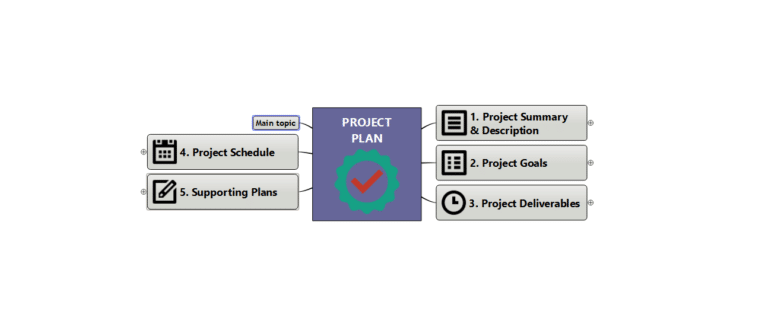
Because of how uncertain and unpredictable the project planning phase can be, it is advisable that is executed systematically and meticulously before the project is started. In this context, there are numerous components that this phase has to incorporate to ensure that project life cycle is followed through flawlessly. Mind mapping provides assistance regarding several aspects of the stage of planning and can improve and refine the whole process. It is flexible and adaptable to changes and modifications, which is an ideal solution when it comes to project planning. By implementing the mind mapping as a complementary technique in project planning, one can more quickly move to the phases of acquiring management approval of the project plan and moving forward to the stage of execution and control of the project.
Mind mapping is characterized by diversity and it is a technique that is widely used in many sectors for a big array of purposes. It is proven that it increases productivity and self-organization, enhances creativity and improves visualization of complex ideas and concepts. In project management, mind maps are mostly utilized for project planning as they can serve as a guiding point for both project managers and team members.
Project managers who use the mind mapping technique must consider various measurable criteria that should be analyzed, evaluated and updated during the planning. In a mind map, these criteria can be presented separately or combined with each other. Often, the decision whether a mind map will contain one or more components depends on the goal and objective that stand behind the composition of it.
Define project scope
For a project plan to be accurate, the first thing that needs to be performed is defining a project scope. Usually determining and presenting the project scope with its tangible or intangible key deliverables, including key milestones, high-level requirements, assumptions, and constraints, is achievable with a mind map.
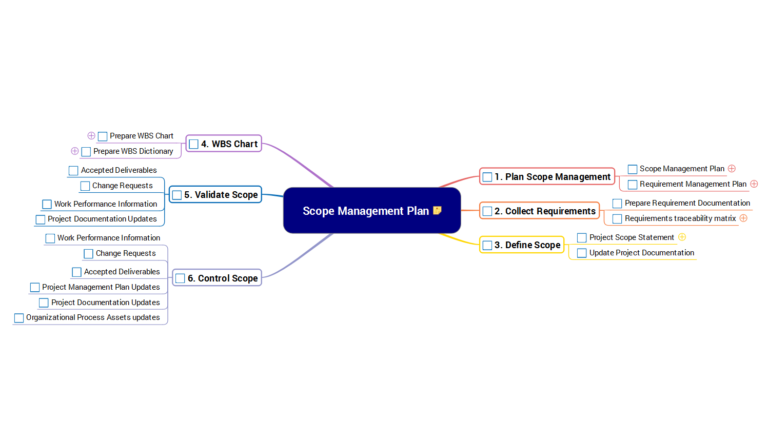
Managing Project Scope Mind Map. Download your copy.
Create action plans
An action plan outlines a strategy for executing a particular action. Developing an action plan in project planning means collecting the fundamentals that need to be taken into consideration in order to reach a predetermined goal. Specifically, action plans often cover essential information such as assigned activities and tasks, resources and periods of time which are indispensable for successfully completing the planning phase.
When an action plan is created, it is preferable that is followed and regularly updated. For example, it is a must that all activities are delegated properly, completed tasks are marked as completed, and pending or delayed activities are discussed and taken care of.
An action plan can be organized and managed with a mind map. But before composing one there are several fundamental points that need to be looked after, such as brainstorming steps that must be taken and evaluating project team’s tasks.
Coordinate team members
Coordination and collaboration can be the strengths or the weaknesses of one team. In order to make them strengths that will lead the project team towards a favorable outcome, it is advisable to implement the mind mapping technique in the process of project planning.
With a mind map, it is possible to prioritize project planning tasks, solve issues faster and coordinate project team members. By composing mind maps that display project tasks by importance, the project manager can follow the working process and completion of tasks without any difficulty.
A mind map is usually branched out differently and according to preferences, so when team coordination is in question, one can organize tasks by priority, estimated time and budget. Arranging tasks in this way is practical for ensuring that important tasks are not omitted and a high level of coordination within the team is kept.
Improve stakeholder communication
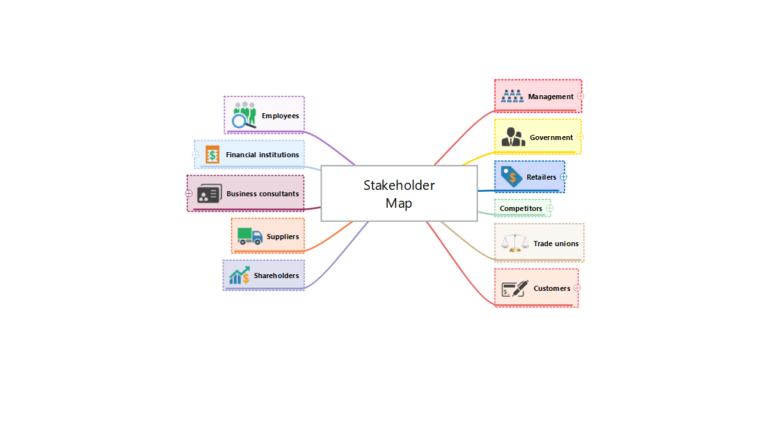
Manage Stakeholders Map Template. Download your copy.
For one relationship to be good is necessary to be is based on continuous communication and collaboration. So in order to build a quality relationship with stakeholders, constantly giving and receiving valuable information is crucial.
Sharing key project information can be easily managed with the mind mapping technique. The mind map supports gathering information in one place and allows sharing it among project participants and stakeholders.
Where can iMindQ help in project planning?
Task management
Task management is an aspect in project planning that focuses on improving prioritization of tasks, internal communication, project participants’ performance, and more. It is used in many organizations with the goal to reach project success.
Task management is related to mind mapping since it is a process that requires good organization and presentation skills. Users of iMindQ can create project plan tasks that contain all the basic elements such as task priority, resources and percentage completed easily by using the Task info feature.
The process of creating tasks using the contextual menu in iMindQ® is very easy and simple. It is possible to connect two tasks from different branches with the use of the relationship functionality. In addition, users can add resources to the tasks using the Task Information window, insert Priority – a visual marker to emphasize the importance of the tasks in the project plan.
Work breakdown structure
The composition of the work breakdown structure is usually developed at the start of a project and it is considered the foundation of the stage of project planning. The work breakdown structure enables project managers to easily define the project scope by planning and managing task information, and also by organizing their project plan into manageable sections.
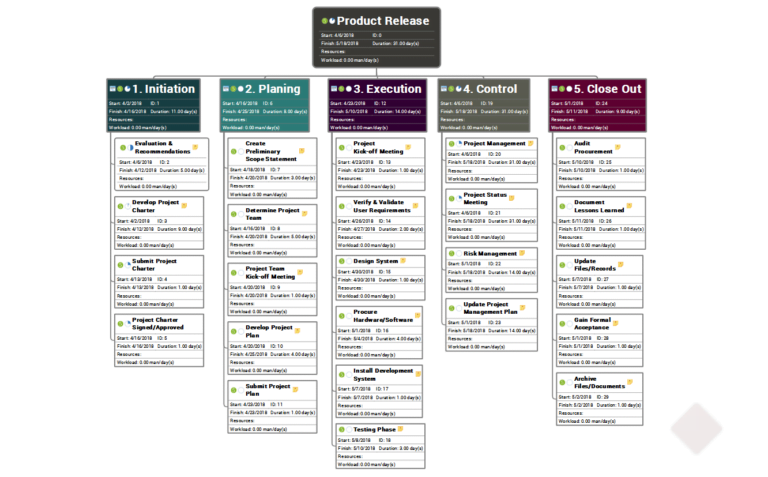
WBS (Product Release) Mind Map. Download your copy.
Gantt chart view
Gantt chart view is one of the most used view while creating a project. It gives a visual representation of the entire plan and plan’s tasks with appropriate info sorted in columns. The Gantt chart helps to determine the start or finish the day for a particular task or to view task’s duration. Gantt chart view can be used for planning and organizing project plans as well for monitoring the project’s progress.
Gantt Table in iMindQ® is customizable which means that user can insert a new column in the associated table of the active view or remove the columns that are not important for the project plan. Adding or removing columns is performed through the contextual menu that pop-ups when the user points the mouse cursor over the header of the table and makes right-button click.
Fishbone Diagram
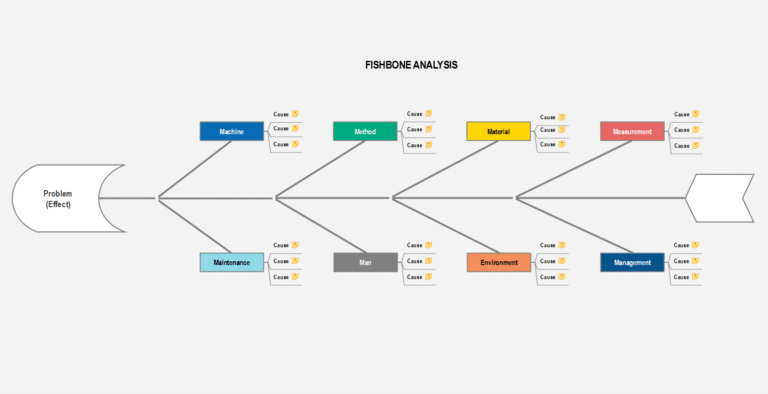
Fishbone Analysis Diagram Mind Map. Download your copy.
